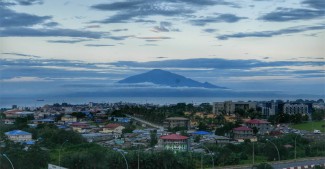The climate community is now in its second week of talks in Sharm el-Sheikh, Egypt, for the UN climate talks, looking to marshal higher ambition towards tackling climate change and the factors that drive it, while encouraging greater efforts and finance towards helping countries adapt to the impacts of climate change and reduce their vulnerability. This is a conversation that cannot stay just within the boundaries of the climate community: it can, and should, bring in actors from other policy fields, including from trade.
Traditionally, the trade policy community’s focus when developing responses to the climate crisis has been on climate mitigation. This usually means looking at how trade policy measures, from unilateral approaches to trade agreements, can help in curbing greenhouse gas emissions and encouraging a move to more sustainable production processes and methods. Liberalizing trade in environmental goods and services, putting in place border carbon adjustment mechanisms to address the risk of climate leakage, and tackling fossil fuel subsidies are all topics that recur in these policy debates and where extensive work has taken place over decades.
While these are crucial conversations, there is much more that trade policy can and should do. Trade can also help governments adapt to the climate change impacts that they are already facing, while building their resilience and preparing for those impacts still to come.
What a changing climate means for trade
The events of recent years have only served to reinforce that extreme weather events, and the disruptions that these events cause, will increase in frequency and severity going forward. Just over the past twelve months, Pakistan has suffered devastating floods that have killed well over one thousand people and left millions without homes or safe drinking water, while Europe has once more been battered by heatwaves and drought. For small island developing states (SIDS) from Tuvalu to the Marshall Islands, the risks posed by sea level rises, tropical cyclones, and changing weather patterns are part of their daily reality. And many of these problems can no longer be reversed. The science bears this out: the Intergovernmental Panel on Climate Change (IPCC) confirmed earlier this year that much of the damage that climate change has wrought on our ecosystems, including on crucial biodiversity, is permanent.
Along with the damage posed to ecosystem and human health, climate change is already affecting what and how countries trade with one another. For instance, changing temperatures and weather patterns have an impact on crop yields, and therefore agricultural trade. Climate change can cause severe and costly disruptions to trade-related infrastructure, as sea level rises threaten seaports and rising temperatures affect and degrade railways. Tourism is another sector that is both crucial for trade and where changing weather conditions are affecting where people travel and the infrastructure that tourism relies on.
Why national adaptation plans are crucial in formulating trade policy responses
These are sobering developments, but there is also extensive data and analysis available on what adaptation actions are needed, and in which contexts, which can and should inform trade policymakers as they determine their next steps. This information can be found in the National Adaptation Plans (NAPs) that developing country governments are formulating and implementing. These NAPs are comprehensive policy instruments, outlining a governments’ adaptation priorities, as well as the strategies and domestic measures for translating these priorities into practice. The process of putting these plans together is invaluable. It involves extensive analysis of a country’s climate-related risks and vulnerabilities and measures to help reduce and manage these challenges, while building adaptive capacity. It also draws from the expertise of a wide range of stakeholders. Developing a NAP means trying to embed climate change adaptation in standard development decision-making, rather than advancing it through isolated, ad hoc efforts. Once a NAP is published, governments can work on allocating and/or obtaining the necessary financing and other resources for putting the plan into practice, assessing the results, and determining where strategies and related measures need to change.
To date, there are 38 NAPs that governments have submitted to the United Nations Framework Convention on Climate Change (UNFCCC) through its NAP Central portal. Out of 154 developing countries, 129 have a NAP process underway. In addition, over a half dozen countries have submitted sectoral NAPs or other outputs. Four of the NAPs submitted by June 30, 2022, name trade and/or finance as a priority sector, according to the latest data from the NAP Global Network’s NAP Trends database.
Even outside of those NAPs that name trade and/or finance as a sectoral priority outright, NAPs cover sectors most acutely affected by climate change -- from agriculture and forestry to tourism and infrastructure -- which in turn have implications for trade. These NAPs therefore have important lessons for the trade community, as do the teams that have worked diligently to put these NAPs together, translate these plans into reality, and evaluate their effectiveness.
Organizing trade policy around three pathways
A 2021 report by the International Institute for Sustainable Development (IISD) sets out three overarching pathways where trade could support efforts at climate adaptation. One pathway involves the unilateral measures that governments can take at a domestic level, such as by lowering tariffs for adaptation goods and services, subsidizing those goods and services while tackling those subsidies that complicate adaptation efforts, and updating government procurement policies and rules to support “green” or sustainable procurement. Many of these measures can serve the dual purpose of helping countries adapt to climate change, while supporting climate change mitigation.
The second pathway outlined in the IISD report involves the role of trade-related financing mechanisms, such as the WTO-led Aid for Trade Initiative’s role in improving governments’ access to much-needed adaptation finance, along with the Enhanced Integrated Framework’s diagnostic tools, which countries use in determining their trade priorities and the support they need for achieving them. The third pathway sets out the need for platforms and forums where governments can come together and determine where they can cooperate and collaborate as they craft trade policy responses for climate adaptation.
For these pathways to be successful, they can and should draw from NAPs and the teams that prepare, implement, and monitor such plans. Their expertise is vital for ensuring that the trade policy measures that emerge from these pathways are appropriate for their local contexts, and account for how the impact of these measures may change over time. It is a big exercise, but a necessary one in light of the existential threat that communities around the world are already facing, and where those bearing the brunt of the impacts are often those who bear the least responsibility for the climate crisis.
---
This article is part of a series dedicated to climate and trade.
Photo by Chester Ho on Unsplash
If you would like to reuse any material published here, please let us know by sending an email to EIF Communications: eifcommunications@wto.org.



